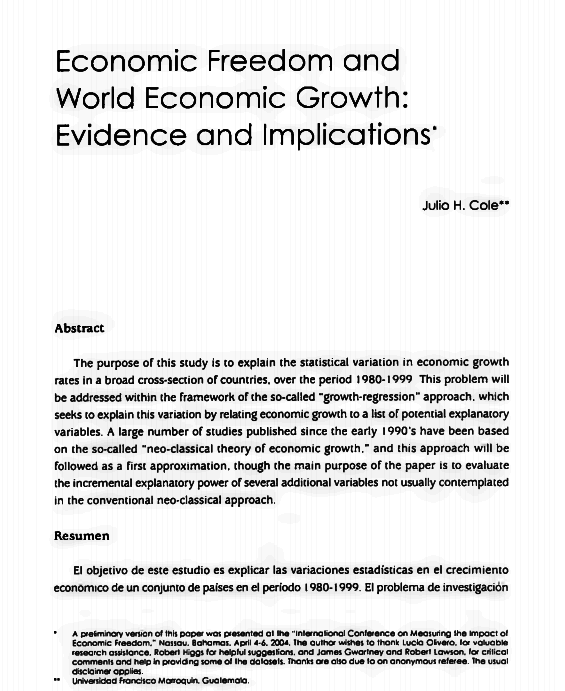Libertad económica y crecimiento económico mundial: Evidencia e implicaciones
DOI:
https://doi.org/10.35319/lajed.20055254Palabras clave:
Crecimiento económico, Libertad económicaResumen
El objetivo de este estudio es explicar las variaciones estadisticas en el crecimiento economico de un conjunto de paises en el periodo 1980-1999. El problema de investigacion se enmarca en el enfoque llamado 'regresión del crecimiento', que trata de explicar esta variación al relacionar el crecimiento económico con una serie de potenciales variables explicativas. Un gran número de estudios que se han publicado a principios de la decada de 1990 han sido fundamentados en la 'teoria neoclásica del crecimiento económico', y este enfoque es seguido como una primera aproximación, aunque el objetivo principal del documento es la evaluación del poder explicativo de un creciente número de variables adicionales que no son usualmente contempladas en el enfoque convencional neoclásico.
Descargas
Citas
Ainsworth, M., Beegle, K. and Nyamete, A. (1996) “The Impact of Women’s Schooling on Fertility and Contraceptive Use: A Study of Fourteen Sub-Saharan African Countries,” World Bank Economic Review, 10: 85-122.
Barro, R. J. (1994) Economic Growth and Convergence, Occasional Papers No. 46. San Francisco, International Center for Economic Growth.
——— (2001) “Human Capital and Growth,” American Economic Review, 91: 12-17.
Barro, R. J. and Lee, J.-W. (1994) “Losers and Winners in Economic Growth,” in Annual Conference on Development Economics 1993, pp. 267-97. Washington, World Bank.
——— (1996) “International Measures of Schooling Years and School Quality,” American Economic Review, 86: 218-23.
——— (2001) “International Data on Educational Attainment: Updates and Implications,” Oxford Economic Papers, 53: 541-63.
Barro, R. J. and Sala-i-Martin, X. (1992) “Convergence,” Journal of Political Economy, 100: 223-51.
Castro Martín, T. and Juárez, F. (1995) “The Impact of Women’s Education on Fertility in Latin America: Searching for Explanations,” International Family Planning Perspectives, 21: 52-57.
Coale, A. J. (1983) “Recent Trends in Fertility in Less Developed Countries,” Science, 221: 828-32.
Crenshaw, E. M., Ameen, A. Z. and Christenson, M. (1997) “Population Dynamics and Economic Development: Age-Specific Population Growth Rates and Economic Growth in Developing Countries, 1965 to 1990,” American Sociological Review, 62: 974-84.
Dawson, J. W. (1998) “Institutions, Investment and Growth: New Cross-Country and Panel Data Evidence,” Economic Inquiry, 36: 603-19.
Easton, S. T. and Walker, M. A., eds. (1992) Rating Global Economic Freedom. Vancouver, Fraser Institute.
——— (1997) “Income, Growth, and Economic Freedom,” American Economic Review, 87: 328-32.
Ericson, R. E. (1990) The Soviet Union, 1979-1990. Country Studies No. 7. San Francisco, International Center for Economic Growth.
Gallup, J. L., Sachs, J. D. and Mellinger, A. D. (1999) “Geography and Economic Development,” in Annual World Bank Conference on Development Economics 1998, pp. 127-70. Washington, World Bank.
Gwartney, J. D., Block, W. E. and Lawson, R. A. (1996) Economic Freedom of the World: 1975-1995. Vancouver, Fraser Institute.
Gwartney, J. D. and Lawson, R. A. (2002) Economic Freedom of the World—2002 Annual Report, Vancouver, Fraser Institute.
——— (2003) “The Concept and Measurement of Economic Freedom,” European Journal of Political Economy, 19: 405-30.
——— (2004) “What Have We Learned from the Measurement of Economic Freedom?”, in The Legacy of Milton and Rose Friedman’s “Free to Choose”: Economic Liberalism at the Turn of the 21st Century, pp. 217-38. Dallas, Texas: Federal Reserve Bank of Dallas.
Hirschman, C. and Guest, P. (1990) “The Emerging Demographic Transitions of Southeast Asia,” Population and Development Review, 16: 121-52.
Jain, A. K. (1981) “The Effect of Female Education on Fertility: A Simple Explanation,” Demography, 18: 577-95
Kelley, A. C. (1988) “Economic Consequences of Population Change in the Third World,” Journal of Economic Literature, 26: 1685-1728.
Knight, M., Loayza, N. and Villanueva, D. (1993) “Testing the Neoclassical Theory of Economic Growth,” IMF Staff Papers, 40: 512-41.
Knodel, J., Havanon, N. and Sittitrai, W. (1990) “Family Size and the Education of Children in the Context of Rapid Fertility Decline,” Population and Development Review, 16: 31-62.
Lau, L. J., ed. (1990) Models of Development: A Comparative Study of Economic Growth in South Korea and Taiwan. San Francisco, International Center for Economic Growth.
Leamer, E. (1975) “A Result on the Sign of Restricted Least-Squares Estimates,” Journal of Econometrics, 3: 387-90.
Mankiw, N. G., Romer, D. and Weil, D. N. (1992) “A Contribution to the Empirics of Economic Growth,” Quarterly Journal of Economics, 107: 407-37.
Maudlin, W. P. (1981) “Patterns of Fertility Decline in Developing Countries, 1950-75,” in N. Eberstadt, ed., Fertility Decline in the Less Developed Countries, pp. 72-96. New York, Praeger.
Nutter, G. W. (1959) “The Structure and Growth of Soviet Industry,” Journal of Law and Economics, 2: 147-74.
——— (1968) “The Soviet Economy: Retrospect and Prospect,” in M. M. Drachkovitch, ed., Fifty Years of Communism in Russia, pp. 75-98. University Park, Pennsylvania State University Press.
Ofer, G. (1987) “Soviet Economic Growth: 1928-1985,” Journal of Economic Literature, 25: 1767-1833.
Pritchett, L. (2001) “Where Has All the Education Gone?” World Bank Economic Review, 15: 367-91.
Sachs, J. D. (2000) “Tropical Underdevelopment,” CID Working Paper No. 57. Center for International Development, Harvard University.
Sala-i-Martin, X. (1996) “The Classical Approach to Convergence Analysis,” Economic Journal, 106: 1019-36.
Sarel, M. (1995) “Demographic Dynamics and the Empirics of Growth,” IMF Staff Papers, 42: 398-410.
Solow, R. M. (1956) “A Contribution to the Theory of Economic Growth,” Quarterly Journal of Economics, 70: 65-94.
Tsiang, S. C. (1984) “Taiwan’s Economic Miracle: Lessons in Economic Development,” in A. C. Harberger, ed., World Economic Growth, pp. 301-25. San Francisco, ICS Press.
White, H. (1980) “A Heteroskedasticity-Consistent Covariance Matrix Estimator and a Direct Test for Heteroskedasticity,” Econometrica, 48: 817–38.
Wilson, C. (2001) “On the Scale of Global Demographic Convergence, 1950-2000,” Population and Development Review, 27: 155-71.





